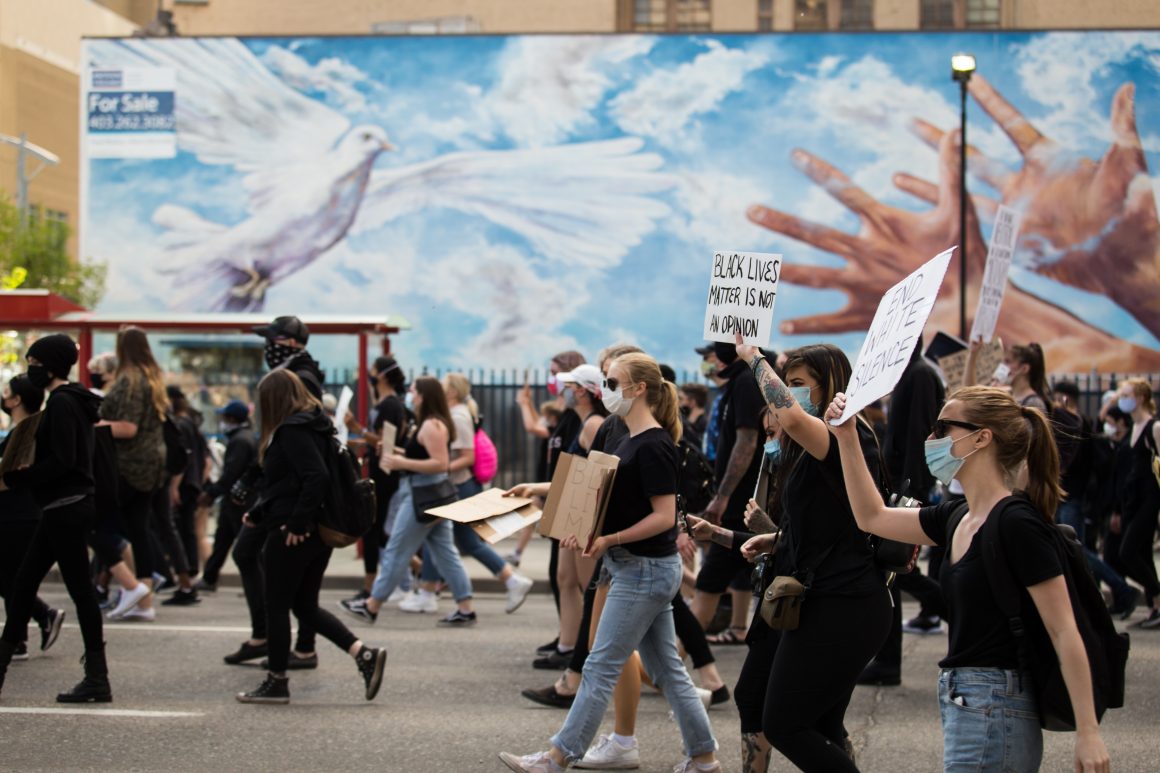
Why we should support the BLM murals project
By Rukhsar Ali, September 23 2020 —
Pink Flamingo’s Black Lives Matter (BLM) summer murals project was postponed to summer 2021 and their proposed location changed after project organizers received racist backlash about the location and subject matter of the mural.
Commenters used terminology such as “Black supremacy,” “ghetto,” and “BLM propaganda,” to attack the proposed mural which was originally meant to replace Doug Driediger’s 25-year-old mural “Giving Wings to the Dream” on 7th Avenue. According to Pink Flamingo’s Facebook page, through community support they have begun “an additional, privately funded mural project” in Chinatown called “The Guide & Protector” by Jae Sterling, which has also faced backlash by protestors.
Although keeping Driediger’s 7th Avenue mural was the backbone of many Calgarians’ arguments against the new mural, the racist rhetoric Pink Flamingo organizers received at the time, and have continued to face at the Chinatown location, make it clear that for a vocal minority, location was a scapegoat meant to distract from the real issue: BLM’s message is not welcome by many in Calgary.
What this location conflict has really asserted is that Black, Indigenous people and people of colour (BIPOC) are allowed their representation in separate designated spaces, so long as their voices do not infiltrate the public sphere of the dominant culture, as proven by the continued racism surrounding the murals.
These murals come at an important time following worldwide BLM protests in response to systemic racism and particularly, police brutality. Although naysayers were initially satisfied with the mural’s move from 7th Avenue, there are still those against the public Chinatown location, indicating that it was only acceptable to move the mural if it remained relatively invisible, asserting that representation “can exist, yes, but only” where the oppressor deems it appropriate. This very sentiment is one allies need to push back against by supporting Pink Flamingo’s project and not only acknowledging but facilitating the need for Black representation to make BLM and anti-racist progress in this city.
At its heart, BLM informs and educates us on the fact that all lives cannot matter until Black lives matter, making this a call to address racial inequalities and encourage others to address their own racism, whether explicit or underlying, and ultimately change mindsets to eliminate the barriers that Black people face due to systemic racism. Thus, this call to action is not asking for us to create a separate space for Black and Indigenous people — who also face systemic racism — outside the public sphere, or asking us to treat these groups above the rest. Rather, it wants us to make anti-racism an active, visible practice in our schools, workplaces and communities, thereby equalizing opportunities that are otherwise inaccessible to them and ensuring their security from violence and police brutality that no other racial groups are as disproportionately disposed to.
To answer this call, equalize representation in society and live a truly anti-racist lifestyle which continually aims to correct the injustices of racial oppression, it becomes crucial for privileged people to use their positions to help advocate for and facilitate the reclaiming of the public spaces that BIPOC have historically been denied. For those who have benefited from the oppression of Black and Indigenous peoples the unlearning process is often uncomfortable, as it should be, because the act of anti-racism demands giving up privilege and the claim to spaces which oppressors never had a right to in the first place.
As a non-Black, non-Indigenous person of colour, I enthusiastically want to see Black and Indigenous faces on a highly public mural. I want to see their stories celebrated and I want to acknowledge their significant presence in my city, while being reminded everyday that I need to work on my own anti-racism in order to make this city as safe for them as it is for me.
Forcing the move of the BLM mural from the original 7th Avenue location went against the reclamation of public space that the movement demands and now, with the racism received at the Chinatown location, vocal allyship and support within Calgary is more important than ever. BIPOC need to see themselves and their stories represented in the public eye, because the anti-racism project needs to be seen by all people — themselves, allies, and racists alike.
The BLM mural in Calgary is significant and merits widespread, universal support because it highlights that systemic racism has made it so that Black lives are less valued while all other lives benefit to some extent from their oppression. Black and Indigenous lives need our attention and fierce support right now, and our public spaces should reflect that: because all lives cannot matter until Black and Indigenous lives matter.
This article is part of our Opinions section and does not necessarily reflect the views of the Gauntlet’s editorial board.
